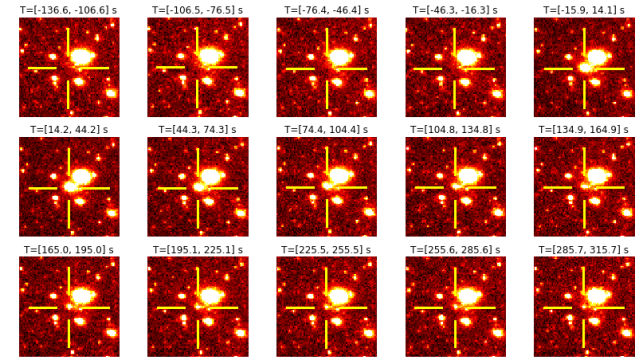Snapshot of burst via S.Karpov, G.Beskin (SAO RAS and Kazan Federal University, Russia), S.Bondar, E.Ivanov, E.Katkova, N.Orekhova, A.Perkov (OJS RPC PSI, Russia), A.Biryukov (SAI MSU and Kazan Federal University, Russia), V.Sasyuk (Kazan Federal University, Russia)
A flash of visible light recently appeared in the sky that, depending on your location, could have been visible with binoculars. It wasn’t a plane or a star: it was a gamma ray burst, one of the most violent kinds of explosions in the universe, from a source 9 billion light years away, possibly a black hole. And you’re afraid of explosions here on Earth? That’s cute.
This gamma ray burst, named GRB 160625B, was special. NASA’s Fermi Gamma-ray Space Telescope gamma ray burst monitor picked it up, and just three minutes later its Large Area Telescope started monitoring the location. The telescope watched the light show happen live and evolve over time. That was a new type of observation that could help scientists understand exactly what causes these massive bursts.
“It’s the first measurement of this type,” study author Eleonora Troja, scientist from the NASA Goddard Space Flight Center, told Gizmodo. “We managed to achieve very good results because the explosion was really bright.”
Just four minutes after the initial detection, the MASTER-IAC telescope in Tenerife, Spain picked up one of the explosion’s most exciting features: the optical light (the stuff our eyes can see) seemed to be polarised. Unpolarized light vibrates in random directions perpendicular to the direction it moves. Polarised light waves vibrate only in one direction, like up and down or left and right. Think about a polarised lens: It only lets light vibrating in one direction through, so if you stack lenses up and they aren’t aligned properly, no light gets through and they turn black.
But this is more than just an interesting observation. This light most likely originated from collimated jets of particles spewing from a young black hole. The polarised nature of the light means that the area around the black hole could have had a strong magnetic field, which would be an important piece of information missing from observations but present in theories, said Troja. “That’s the only thing that can explain the polarization and all the data we collected.” The researchers published their results today in the journal Nature.
Others were excited about the results. Astronomer Nissim Fraija from the National Autonomous University of Mexico told Gizmodo “it’s exciting to learn about the structure of magnetic field at an early stage of the jet” coming from the black hole.
“The detection of polarization in a prompt emission of a gamma ray burst is a big deal,” astrophysicist Alexander Tchekhovskoy from the University of California told Gizmodo. “We actually don’t understand what causes the optical emissions of gamma ray bursts,” or whether the visible light and gamma rays originate from the same place.
Tchekhovskoy reminded me that GRBs are complex — the jet of energy still must pass through the medium around its source, which creates shock waves travelling forward and backwards. Those shock waves could be where the visible light comes from. He pointed out that this is beautiful data that presents a compelling argument, but it was also a difficult observation with lots of moving pieces.
“It’s an exciting possibility that the optical emission actually comes from the same places as the gamma rays,” he said, “If we detect more of these we’ll be able to say for certain if this is a rule rather than the exception.”
Troja herself said that there are other theories to what causes the GRBs, like maybe neutron stars instead, but thought that explanations have been converging on the idea that they come from black hole-based processes. She also pointed out that the observation is limited by the strength of the telescopes and amount of data collection time.
But regardless, there’s no doubt that GRB160625B is special.
“Any amateur astronomer with just binoculars looking in the right part of the sky could have recorded the explosion,” said Troja. “It was really really bright, and it also lasted for a very long time… it was such a unique event.”
[Nature]
